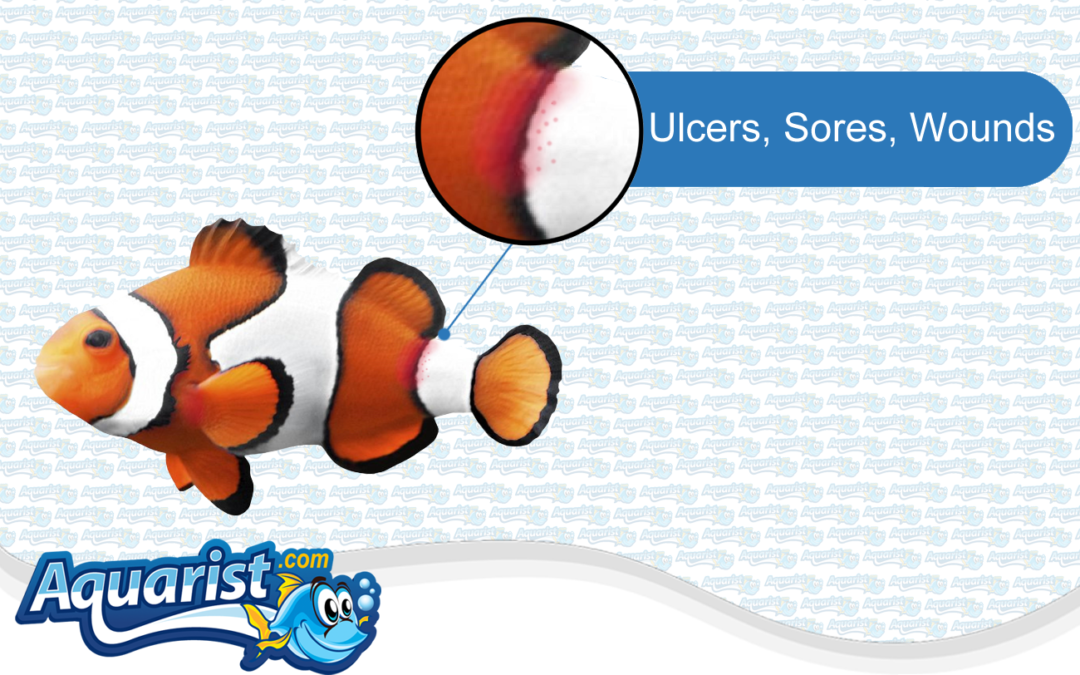Comprehensive Guide to Saltwater Fish Diseases: Ulcers, Sores, and Wounds
Ulcers, sores, and wounds are common health issues in saltwater fish that can arise from a variety of causes, including injuries, bacterial infections, and parasitic infestations. If left untreated, these open wounds can lead to serious complications such as secondary infections and even death. This guide provides a detailed overview of ulcers, sores, and wounds in saltwater fish, covering their causes, symptoms, treatment options, and preventive measures.
What Are Ulcers, Sores, and Wounds in Fish?
Ulcers, sores, and wounds in saltwater fish are open lesions that can appear on the skin, fins, or other body parts. They may be caused by trauma, infections, or underlying health conditions. Ulcers are often characterized by deep, open sores with raised edges, while sores can be shallower and less defined. Wounds are typically caused by physical injuries but can become infected if not properly treated.
Causes of Ulcers, Sores, and Wounds
Several factors can lead to the development of ulcers, sores, and wounds in saltwater fish. Common causes include:
- Physical trauma: Injuries from aggressive tank mates, sharp tank decorations, or rough handling can cause open wounds.
- Bacterial infections: Bacteria such as Aeromonas and Pseudomonas can infect open wounds, leading to ulcer formation.
- Parasitic infestations: Parasites such as flukes, copepods, and marine leeches can cause skin damage that leads to sores or ulcers.
- Poor water quality: High levels of ammonia, nitrite, or nitrate can stress fish and weaken their immune systems, making them more susceptible to skin infections and wounds.
- Fungal infections: Fungi can invade existing sores or wounds, leading to a worsening of the condition.
Symptoms of Ulcers, Sores, and Wounds
Identifying ulcers, sores, and wounds early can help you take prompt action to prevent the spread of infection. Look out for the following signs:
- Red, inflamed areas: The affected areas may appear red, swollen, or irritated.
- Open sores or lesions: Ulcers may present as deep, open wounds with ragged edges, while sores may be more superficial.
- Loss of scales or skin: The skin around the wound may appear damaged or missing, exposing the underlying tissue.
- Excessive mucus production: Fish may produce more mucus in an attempt to protect the affected areas.
- Behavioral changes: Infected fish may exhibit lethargy, reduced appetite, or seek isolation from other tank mates.
Treatment Options for Ulcers, Sores, and Wounds
Proper treatment is crucial to help your fish recover from ulcers, sores, and wounds. Follow these steps to manage the condition effectively:
- Isolate the affected fish: Quarantine the fish in a separate tank to prevent the spread of infection and provide a controlled environment for healing.
- Improve water quality: Perform regular water changes and monitor water parameters to ensure optimal conditions. Clean water helps promote healing and reduces the risk of secondary infections.
- Use antibacterial medications: Apply antibacterial treatments such as kanamycin, nitrofurazone, or other broad-spectrum antibiotics to combat bacterial infections.
- Apply topical treatments: If possible, apply topical medications such as iodine or antibiotic ointments directly to the wound. This should only be done under controlled conditions, such as when the fish is temporarily out of water for treatment.
- Add aquarium salt: For saltwater tanks, increasing the salinity slightly can help reduce stress and support the fish's immune system. However, this should be done with caution, as some fish species are sensitive to changes in salinity.
- Use medicated foods: Feeding fish medicated food containing antibiotics can help treat internal infections and support overall healing.
Preventing Ulcers, Sores, and Wounds
Prevention is always better than treatment when it comes to fish health. The following steps can help reduce the risk of ulcers, sores, and wounds in saltwater fish:
- Maintain optimal water quality: Regularly test and monitor water parameters, including ammonia, nitrite, and nitrate levels. Perform routine water changes to keep the tank clean and healthy.
- Choose compatible tank mates: Avoid keeping aggressive or territorial species together to reduce the risk of injuries from fights.
- Provide a safe tank environment: Remove sharp or rough decorations that could cause injury. Ensure that the tank is spacious enough for all fish to swim freely without overcrowding.
- Quarantine new fish: Quarantine new arrivals for at least 2-4 weeks before introducing them to the main tank to avoid introducing pathogens or parasites.
- Feed a balanced diet: Provide a varied diet that includes high-quality foods to boost the immune system and promote healing.
Pro Tips for Treating and Preventing Ulcers, Sores, and Wounds
- Act quickly: Early intervention can prevent minor wounds from becoming severe ulcers. Prompt treatment increases the chances of a full recovery.
- Monitor water parameters closely: Poor water quality can exacerbate skin conditions. Regularly check water parameters and make adjustments as needed.
- Use natural healing aids: Products like Melafix (made from tea tree oil) can be used as a natural remedy to support healing and reduce inflammation.
- Disinfect the quarantine tank: After treating infected fish, thoroughly clean and disinfect the quarantine tank and any equipment used to prevent future infections.
Common Mistakes to Avoid When Treating Ulcers, Sores, and Wounds
To ensure effective treatment and avoid complications, be mindful of these common mistakes:
- Stopping treatment too early: Even if the wounds appear to heal, continue the full course of treatment to ensure the infection is fully eradicated.
- Overusing medications: Avoid using multiple medications at once without guidance, as this can stress the fish and negatively affect water quality.
- Not addressing underlying causes: If poor water quality, aggressive tank mates, or other stress factors are not addressed, the risk of recurring ulcers remains high.
- Neglecting quarantine: Skipping quarantine for new fish can introduce pathogens into the main tank, increasing the likelihood of disease outbreaks.
Understanding the Impact of Ulcers, Sores, and Wounds on Fish Health
Ulcers, sores, and wounds can significantly affect the health and well-being of saltwater fish. Open lesions not only cause discomfort and stress but also increase the risk of secondary infections, which can be fatal if left untreated. Proper diagnosis, timely treatment, and preventive measures are essential for maintaining a healthy aquarium environment and ensuring the long-term health of your fish.
Conclusion
Ulcers, sores, and wounds are serious health issues that require prompt attention in saltwater fish. By recognizing the symptoms, understanding the causes, and using effective treatment methods, you can help protect your fish from these conditions. Always maintain optimal water quality, provide a safe tank environment, and take preventive measures to minimize the risk of injury and infection. With proper care and timely intervention, you can ensure the health and well-being of your saltwater fish.

